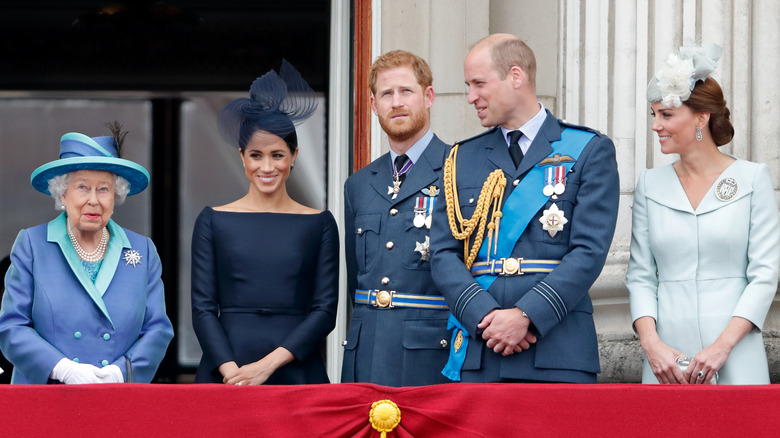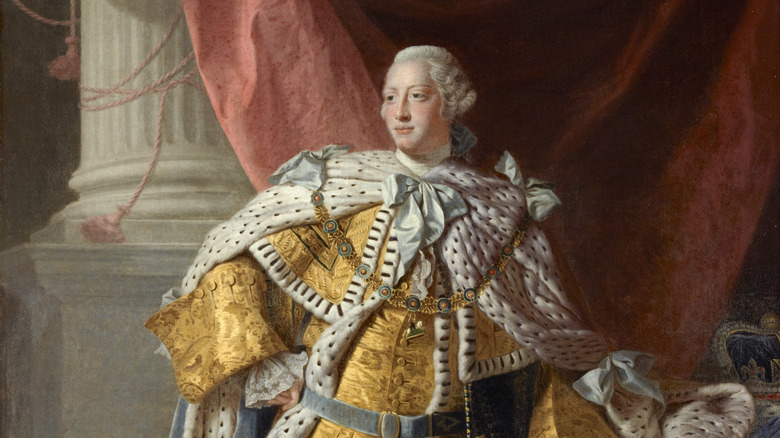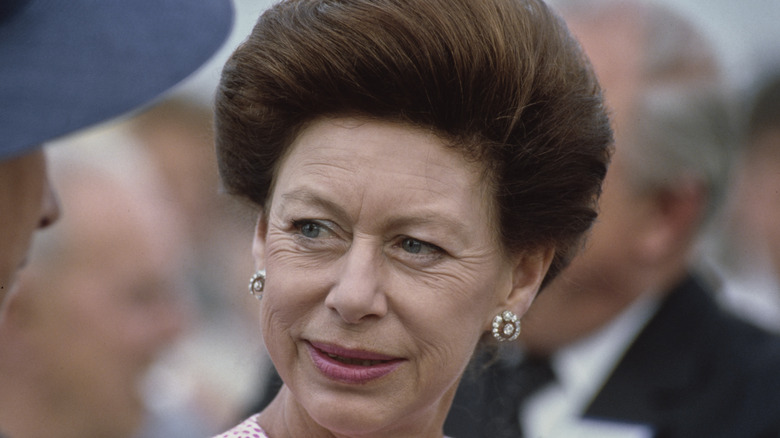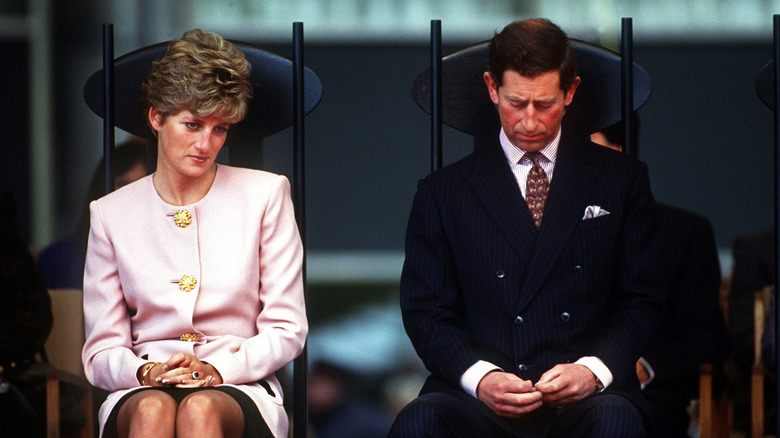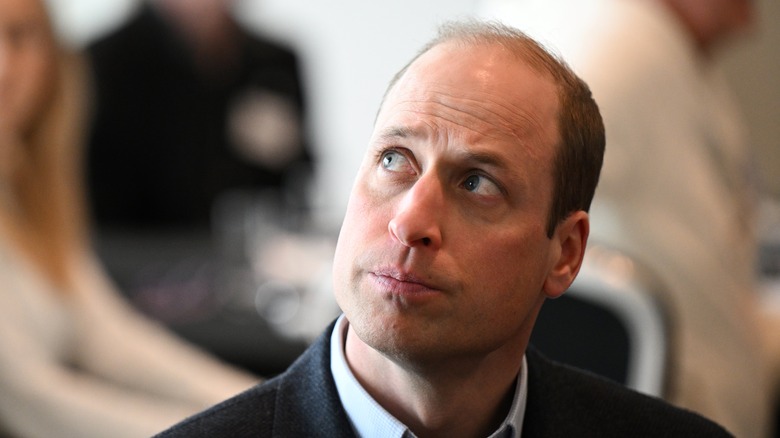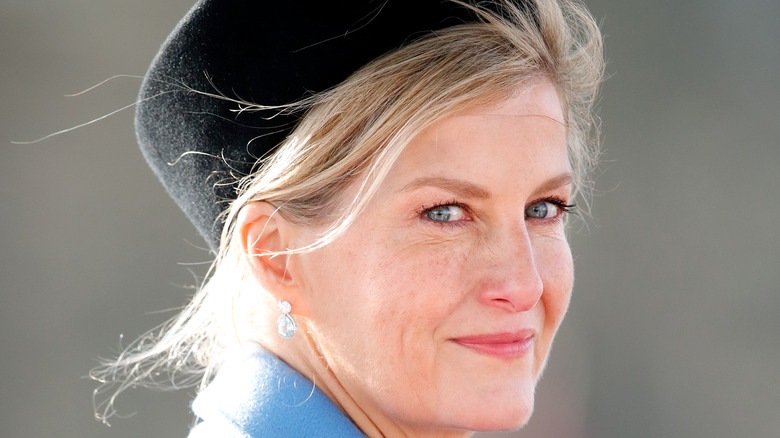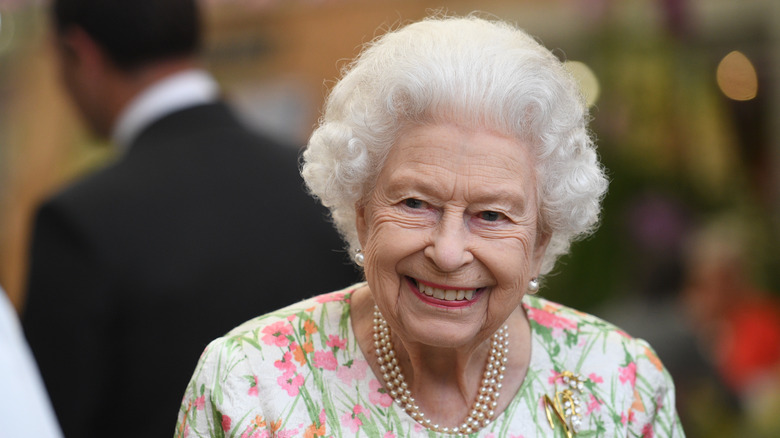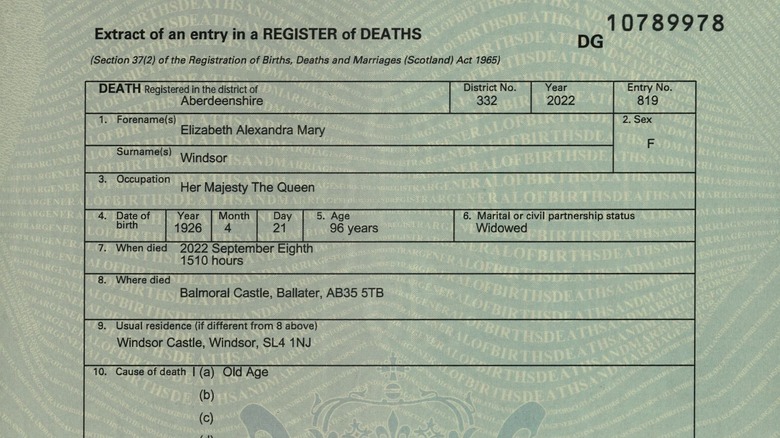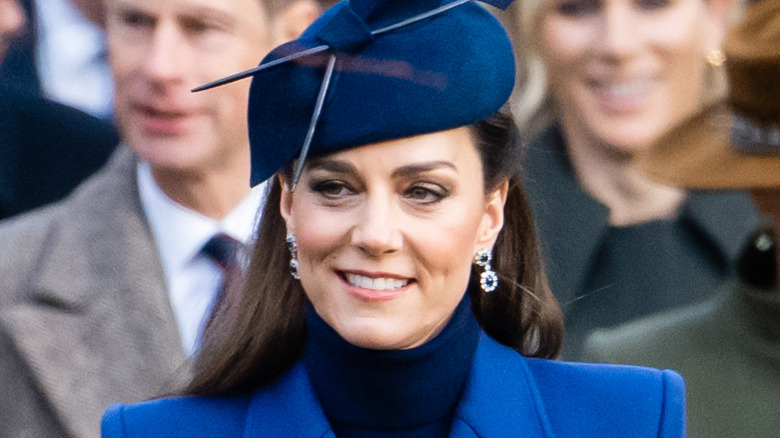Serious Health Problems The Royal Family Tried To Hide
The British royals occupy a tricky position when it comes to disclosing health issues. On one hand, they are individuals who don't necessarily need or want to explain every sniffle. Yet, there's no denying that modern royals are public figures. In 2013, novelist Hilary Mantel gave a now-infamous speech (published by the London Review of Books) that examined this odd tension experienced by British royals, in which we seemingly expect them to maintain perfect images while also allowing for intense, intrusive interest in their most personal matters. To Mantel, it resulted in an emotionally flattened effect, even on the widely beloved Queen Elizabeth II.
The long-held informal motto of Elizabeth — "never complain, never explain" – complicates things even further. This stiff-upper-lip ethos meant that she and many of her family members kept things quiet, even if the behind-the-scenes reality was chaotic. It worked fairly well to maintain the royal image over the years, apart from the upset caused by Elizabeth's initial non-response to the widely beloved Princess Diana's death in 1997.
Since the queen's 2022 death, however, royals have become more open about their health and other personal matters — perhaps the better move in a more connected age. Yet this also opens them up to more speculation over health conditions, whether those are questions about Charles III's swollen fingers or wild speculation surrounding Kate Middleton's mysterious 2024 abdominal surgery. Here are some of the most notorious cases where the British royal family tried to hide some serious health issues.
George III's mental health updates were vague
Today, George III's mental health is one of the first things many people know about him. But that's not entirely fair, as George had quite a few years where he was able to rule on his own, starting in 1760 and lasting until his first instance of serious instability in 1788-1789. He recovered from this extended episode, but recurring struggles with mental illness left him unable to act as king by 1810, and until his death in 1820.
What did the British public know about their king's illness? Not a whole lot. Most understood the king was sick, as his doctors routinely issued bulletins that gave updates on his condition. But those were often kept purposefully vague. Instead of giving detailed information about George and how he was being treated, these documents — which weren't necessarily signed by the doctors directly involved with the king's treatment — were more an attempt to soothe public worries.
But, while these reports tried to allay fears of an unstable monarchy, they also fed into the growing sense of the royals as public figures whose activities were fodder for the flourishing British newspaper industry. Though readers might not have known that the king was subjected to treatments that involved straitjackets and isolation, they certainly had the sense that not all was well within the dynasty.
The Bowes-Lyons reportedly faked two disabled family members' deaths
The story of Elizabeth II's cousins, Katherine and Nerissa, is a supremely sad one. The sisters, who were born to Fenella Bowes-Lyon and John Herbert Bowes-Lyon (Elizabeth II's maternal uncle), were born with intellectual and developmental delays that left them largely nonverbal. In 1941, they were sent to the Royal Earlswood Hospital (pictured), where Nerissa died in 1986 and Katherine in 2014.
The Bowes-Lyon family seemed to do all they could to ignore the existence of Katherine and Nerissa. Their mother reportedly visited them for the rest of her life (she died in 1966), but there are no confirmed visits from other family members, much less Christmas gifts or even a hastily scribbled card. In fact, by the 1960s, Burke's Peerage, an aristocracy-focused publisher, was reporting that Katherine and Nerissa were dead (their mother seems to have failed to fill out the part of the form that admitted their whereabouts). Still, family money came in to pay for their care.
The truth came out when an April 1987 story in The Sun broke the news of the two sisters, including the still-living Katherine. Later, it came out that three more disabled family members had been subjected to similar treatment, bringing the number of known institutionalized cousins of Queen Elizabeth to five. Supposedly, the Queen Mother had believed that her nieces were dead until 1982. After The Sun's report, she sent them money, but appears to have never visited Katherine.
George VI had myriad health issues
By the end of his days, George VI was in a pretty bad way. The 56-year-old monarch, who had been a heavy smoker for much of his life, suffered from hardening of the arteries, dealt with leg and foot pain so bad his doctors considered amputation, and underwent a 1949 operation to remove part of his right lung. By 1951, doctors concluded that he had lung cancer, adding to the tragic cancer history of British royals. In September of that year, surgeons — working in an operating room set up in Buckingham Palace — removed George's left lung and part of a nearby nerve, a procedure that appeared to slow his speech afterward.
Yet, despite public bulletins that addressed the king's wavering health, none appear to have mentioned cancer. George himself may not have known that a cancer diagnosis was on the table, while not all of the king's doctors were fully aware of his condition, either. When the king was found dead in his bedroom at Sandringham on February 6, 1952, the doctor who attended the scene said he had died of a coronary thrombosis, a blood clot that caused a heart attack. Yet, an autopsy was never performed to confirm this.
When the reality of his condition came out decades later, doctors and historians suggested that the royal family covered it up because they wanted to project the image of a stable monarchy and avoid the perceived shame of a cancer diagnosis.
Princess Margaret's depression was swept under the rug
Though she was born into a life of stupendous privilege, it's hard to deny that Princess Margaret had a difficult life that seemed to be the focus of every tabloid. Yet, Margaret's health issues were often far more concealed.
It didn't help that Margaret had a considerable smoking habit that reportedly saw her smoke up to 60 cigarettes daily. Her addictions eventually grew to include alcohol, which often began with a vodka-laced breakfast. Her marriage to photographer Anthony Armstrong-Jones deteriorated through the '60s and '70s, and caused serious personal upset. Margaret often retreated to the private Caribbean island of Mustique, but she still allegedly had a nervous breakdown in 1974.
While her physical ailments became widely known — at the time of her 2002 death, the public was well aware of her three strokes, a lung biopsy, pulmonary issues, and hepatitis, among other maladies — Margaret's mental health struggles were kept quiet. There was some talk of her breakdown, but it took more time for the public to learn that Margaret sought treatment for depression, as well as her attempts at self-harm. That was in part due to her family's penchant for ignoring inconvenient issues. During one party, Margaret reportedly threatened to throw herself out of her bedroom window. When her sister was called, Elizabeth shrugged it off, saying, "Her bedroom is on the ground floor" (via Woman & Home).
It took years for Charles III to fully explain a serious polo accident
When then-Prince Charles fell off his horse during a 2001 polo match, news outlets casually referred to the incident as a tumble. But a 2006 interview, which aired in the U.S. on Dateline, revealed that his so-called tumble was far more serious than it had seemed. Sitting down with sons William and Harry, Charles said, "I was trying too hard [...] I had to turn the pony very fast and the next thing [...] the pony came down sideways and I must have landed absolutely smack on my head." He claimed that Harry had thought his father was snoring, "and there I was busily swallowing my tongue and quietly dying."
Even if that particular detail is an exaggeration, Charles very obviously suffered head trauma that knocked him unconscious. Looking at the effects on other people who have been knocked out, that could have been a serious, if not deadly, injury.
Charles survived, but it's now obvious that his love of polo had an often-undiscussed effect on his physical health. Harry later wrote in his memoir, "Spare," that Charles still deals with the painful aftereffects of his polo career. According to Harry, Charles could sometimes be found doing headstands to deal with the lingering issues. "Prescribed by his physio, these exercises were the only effective remedy for the constant pain in Pa's neck and back," Harry wrote (via New Zealand Herald).
Princess Diana's mental health was reportedly ignored
Even before the reality of her failing marriage and complicated relationship with her in-laws came to light, Princess Diana appeared to have been suffering from the pressure of a royal life. After her marriage to Prince Charles in 1981, Diana reportedly suffered from bouts of crying, insomnia, paranoia, and the signs of an eating disorder. As some have since claimed, Diana also showed a tendency towards suicidal ideation and self-harm. Charles was reportedly confused and upset by his new wife's troubles. Eventually, their relationship crumbled.
Privately, the royal family attempted to address Diana's mental health, though she was reportedly resistant to taking medication or speaking to a therapist. Queen Elizabeth even asked Harry Herbert, a family friend and royal racing manager, to check in with the princess. Yet, as far as the public was concerned, the details of Diana's mental health were obscure even as her marriage was clearly on its way out.
It wasn't until after Charles and Diana separated in December 1992 that Diana began to more openly discuss her mental health. That resulted in an increased number of people seeking help for eating disorders and mental illness, though the effect eventually waned. Decades later, the royal family reportedly attempted to conceal another member's similar struggles, as Meghan Markle claimed that her depression after her 2018 marriage to Prince Harry was practically ignored as getting help was reportedly deemed to be too potentially damaging for the family's image.
Prince William's didn't disclose a 2020 bout with COVID-19
In 2020, the beginnings of the COVID-19 pandemic sent the world into a morass of lockdowns, mask mandates, and widespread uncertainty. Even royals managed to catch the virus. Prince Charles first contracted it in March 2020, then again in 2022, the same year that his wife and Duchess of Cornwall Camilla grew ill, as well as his mother, Queen Elizabeth. All experienced relatively mild forms of COVID-19 and were never hospitalized.
But, for much of 2020, the family kept a secret: Prince William had been sick, too. In November of that year, The Sun broke the news that William had contracted COVID in April and, despite taking part in 14 remote engagements, had been fairly ill. Other sources claimed he was fine — after all, he did maintain a fairly full work schedule while isolated. Either way, when William finally admitted that he had been sick, he claimed to have kept quiet because he didn't want to worry the British public. While his grandmother Queen Elizabeth was reportedly concerned about William's health, neither was the kingdom was thrown into disarray when his father Charles' first bout with COVID became public knowledge. Even so, perhaps William genuinely didn't want to contribute to a potential panic, or he just wanted to be sick in peace.
Duchess Sophie had a traumatic childbirth experience
On November 10, 2003, the public was informed that Prince Edward and his wife Sophie, then the Earl and Countess of Wessex, had welcomed a baby girl. The official royal announcement noted that Sophie had undergone an emergency c-section, Edward had to rush back from an overseas engagement, and the premature girl, Louise, was in the NICU. However, the announcement made it seem that all was well, calling the NICU stay precautionary and claiming that both mother and newborn were doing well.
Yet Sophie's childbirth experience was genuinely dire. She went into labor about four weeks early and, at the hospital, medical staff determined that she had a placental abruption, in which the placenta begins to separate from the uterus. This is a potential emergency in which the gestating parent can experience dangerously heavy bleeding and the fetus may be deprived of oxygen. Louise was safely delivered, though Sophie required a large blood transfusion and reportedly came dangerously close to death. Even after she became stable, she was unable to see her daughter and faced a long physical and mental recovery.
Of course, it's not as if Sophie was morally obligated to make her traumatic birth experience public knowledge in what must have been an incredibly vulnerable time. Still, when the reality of her first birth became more widely known over a decade later, it may have shocked people who had read the rather sedate royal announcement.
Queen Elizabeth's 2021 rest was actually a hospital stay
By 2021, it was clear that Queen Elizabeth was slowing down. On the throne since 1952, she had ruled for over 70 years, making her one of the longest-reigning monarchs in history. But even with access to top-notch private medical care, time and waning health come for everyone. Yet, when the queen had to call off an engagement in October 2021, Buckingham Palace made it seem as if the then 95-year-old monarch was briefly stepping away from her duties because her physicians had simply told her to rest.
Yet Elizabeth was not taking it easy at home. As news outlets soon reported, she had actually been admitted to a hospital for a one-night stay, undergoing unspecified tests for an unspecified reason. Though it appeared that she wasn't infected with COVID-19 and spokespeople claimed that the queen's medical team was being cautious of something, little else has since emerged about the brief stay.
By this time, the queen's health had become a subject of considerable debate. What, exactly, was going on with her? Reports surfaced that she privately used a wheelchair to deal with mobility issues, though she was set on never letting the public see her using one. Some even speculated that she had a form of bone cancer that may have explained the 2021 hospital stay, reported bouts of pain, and wheelchair usage, though that has never been confirmed.
The public still isn't sure of Queen Elizabeth's cause of death
At the time of Queen Elizabeth II's heart-wrenching death on September 8, 2022, it had been obvious that her health was declining. Previously, she had been put under medical supervision, but details as to why never emerged. Even when her death certificate was released later that month, the listed cause of death — old age — did little to explain what contributed to her passing.
Whether or not someone can really die of old age is a matter of debate amongst medical professionals. Some argue that advanced age is a legitimate cause of death on its own. After all, it is one of the top causes of death in Japan (where, as of 2023, 10% of the nation's population is 80 or older). Yet others argue that a senior's declining body and failing immune system opens them up to any number of complications, which should then be deemed the cause of death. If you ascribe to the latter point of view, Queen Elizabeth's death certificate is frustratingly vague.
Some sources claim that Elizabeth was perhaps in far worse health than many outsiders suspected. As one told The Daily Beast, by the end of her life, the queen was often in a wheelchair and suffered from a variety of pains, declining senses, and cognitive issues, though her death reportedly still caught close family members off guard. A more specific cause of death could clear this up, but we may never learn the full truth of Elizabeth's death.
[Featured image by National Records of Scotland via Wikimedia Commons | Cropped and scaled | OGL v1.0]
Kate Middleton's 2024 abdominal surgery led to a cancer diagnosis
In January 2024, just before her father-in-law, King Charles III, openly announced he had been diagnosed with cancer and was undergoing treatment, Kate Middleton, the future queen consort, suddenly dipped out of the spotlight. A statement from Kensington Palace claimed she was undergoing planned abdominal surgery. Though the procedure reportedly went well, no one specified what kind of surgery Kate had needed and why she required such a long private recovery.
Her husband, Prince William, continued with his duties until February 27, when he missed a memorial service for his godfather. Then, on March 10, Kate shared a Mother's Day photo of herself and her three children online. Observers noted that the image had been awkwardly edited, to the point that major news agencies pulled the photo. The image fueled already-swirling rumors around the nature of the surgery and the state of Kate and William's marriage — she was sans wedding ring in the controversial photo — but no full explanation was proffered. Even what seemed to be clear evidence of Kate appearing in public post-surgery was greeted with suspicion by conspiracy-minded commenters, while the nature of the surgery remained mysterious.
Then, on March 22, the princess made a public announcement that many were grimly expecting: Tests following the surgery had revealed cancer, and she had begun chemotherapy in February, with no further details disclosed as of late-March 2024.
If you or someone you know needs help with an eating disorder, is struggling, or in crisis, help is available, contact the relevant resources below:
-
Call or text 988 or chat 988lifeline.org
-
Visit the National Eating Disorders Association website or contact NEDA's Live Helpline at 1-800-931-2237. You can also receive 24/7 Crisis Support via text (send NEDA to 741-741).
